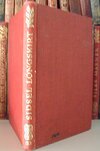Hans Aanrud (1863–1953)
Autor von Sidsel Langröckchen: eine Erzählung aus den norwegischen Bergen
Über den Autor
Bildnachweis: Photo: Vidar Iversen
Werke von Hans Aanrud
Fyrabendsarbeide. 2 Exemplare
Storkarer 2 Exemplare
"En odelsbonde", og andre fortellinger 2 Exemplare
Fortællinger Bind 4 1 Exemplar
Fortællinger Bind 3 1 Exemplar
Fortællinger Bind 2 1 Exemplar
Samlede verker, 3 , Hans Aanrud, 1 Exemplar
Fortællinger B. 3 1 Exemplar
Fortl̆linger. B.4 1 Exemplar
Fortællinger Bind 5 1 Exemplar
Fortællinger B. 1 1 Exemplar
Fra Svipop til Venaasen : nye fortællinger 1 Exemplar
Farvel Fantdal- 1 Exemplar
Téli éjszaka 1 Exemplar
Tuttmüts ja karvmüts : [lastejutud] 1 Exemplar
Samlede verker 1 Exemplar
Samlede verker Bind 1 1 Exemplar
Samlede verker Bind 2 1 Exemplar
Smaafæ 1 Exemplar
Samlede verker Bind 3 1 Exemplar
Nye historier til opplesning 1 Exemplar
Norske noveller / B.1 1 Exemplar
Fortællinger Bind 1 1 Exemplar
Zugehörige Werke
Getagged
Wissenswertes
- Gebräuchlichste Namensform
- Aanrud, Hans
- Rechtmäßiger Name
- Aanrud, Hans
- Geburtstag
- 1863-09-03
- Todestag
- 1953-01-11
- Geschlecht
- male
- Nationalität
- Norwegen
- Land (für Karte)
- Norway
- Geburtsort
- Vestre Gausdal, Norwegen
- Sterbeort
- Oslo, Norwegen
- Berufe
- Schriftsteller
- Kurzbiographie
- Norwegian author Hans Aanrud was born in 1863 in the valley of Auggedalen, in the province of Gausdal. Although he moved to Oslo after he began to enjoy some literary success, the rural life of his early years would inform much of his work. Aanrud wrote plays, poetry and stories, and is particularly remembered for children's books such as Sidsel Sidsærk (1903) and Sölve Solfeng (1910). Aanrud died in 1953. (source: Wikipedia)
Mitglieder
Rezensionen
Listen
Dir gefällt vielleicht auch
Nahestehende Autoren
Statistikseite
- Werke
- 31
- Auch von
- 3
- Mitglieder
- 78
- Beliebtheit
- #229,022
- Bewertung
- 3.6
- Rezensionen
- 5
- ISBNs
- 16
- Sprachen
- 1






